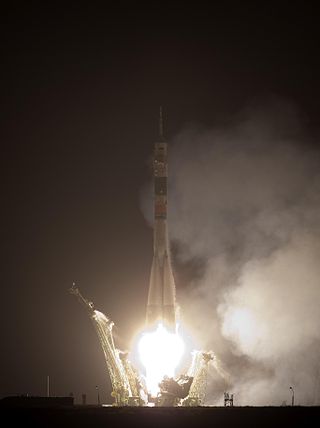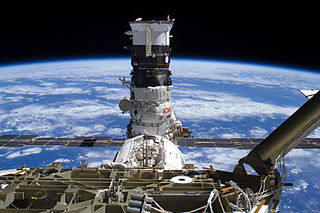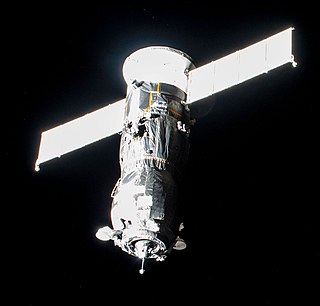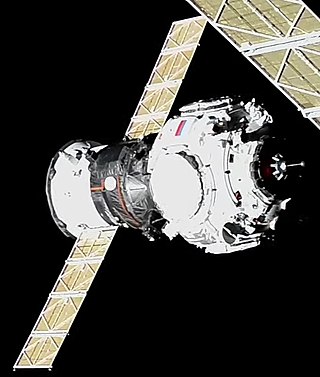

The Russian Orbital Segment (ROS) is the name given to the components of the International Space Station (ISS) constructed in Russia and operated by the Russian Roscosmos. The ROS handles Guidance, Navigation, and Control for the entire Station. [1]


The Russian Orbital Segment (ROS) is the name given to the components of the International Space Station (ISS) constructed in Russia and operated by the Russian Roscosmos. The ROS handles Guidance, Navigation, and Control for the entire Station. [1]

The segment currently consists of six modules, which together essentially comprise the base configuration of the cancelled Russian space station Mir-2. [2] The segment is controlled directly from Roskosmos's Mission Control Center in Moscow. The six modules are (in order of launch):
The first module, Zarya, otherwise known as the Functional Cargo Block or FGB, was the first component of the ISS to be launched, and provided the early station configuration with electrical power, storage, propulsion, and navigation guidance, until a short time after the Russian service module Zvezda docked and was transferred control. Zvezda contains the ESA built DMS-R Data Management System. [3] Now primarily used for storage, Zarya provides ports for Soyuz and Progress spacecraft and the European ATV to dock to the station. Ships boosting the station's orbit dock to the aft port (the rear port according to the station's normal orientation and direction of travel). The FGB is a descendant of the TKS spacecraft designed for the Russian Salyut program. 5.4 tons of propellant fuel can be stored and transferred automatically to and from ships docked. Zarya was originally intended as a module for the Russian Mir space station,[ citation needed ] but was not flown as of the end of the Mir-1 program. Developed by Russia and the former Soviet Union, construction of Zarya was funded by the United States and NASA, [4] and Zarya remains a US-owned module. [5]
The second module, Zvezda, is the station's Service Module - it provides a living environment for the crew, contains the ISS's main engine system, and provides a docking port for Soyuz, Progress and Automated Transfer Vehicle spacecraft. [6]
The fourth module to be launched, Poisk, is similar to Pirs. Redundancy in airlocks allowed one airlock to be repaired internally and externally whilst crew use the other airlock to exit and re-enter the station.
The fifth module to be launched, Rassvet, is primarily used for cargo storage and as a docking port for visiting spacecraft.
The sixth module to be launched, Nauka, also known as the Multipurpose Laboratory Module, is the main laboratory space of the ROS. A backup flight article for FGB-based Zarya , known in production as FGB-2, was originally planned to serve as the Universal Docking Module, though its construction had been halted at 70% completion in the late 1990s. It occupies the former location of Pirs on Zvezda's nadir port.
The seventh module to be launched, Prichal also known as Uzlovoy Module is a nodal module that has a pressurized spherical ball-shaped design with six hybrid docking ports. It is attached to the nadir port of the Nauka module.
Pirs , launched on 14 September 2001, was the third module of the ROS to be launched. It functioned as the ROS's airlock, storing EVA spacesuits and providing the equipment necessary for cosmonauts to exit the space station. It also served as a docking compartment for Soyuz and Progress spacecraft. It was decommissioned and undocked by Progress MS-16 on 26 July 2021, and burned up in the atmosphere, to make way for the Nauka module. [7]
This article needs additional citations for verification .(September 2022) |
On 17 June 2009, the Russian Federal Space Agency (Roskosmos) presented to NASA and the other ISS partners a proposal to add additional modules to the Russian segment to ensure its viability past 2016 or even 2020.
It was planned that the two larger modules, nominally referred to as NEM 1 and 2, would be lifted to orbit via Angara A5 launchers in the mid-2020s and would be attached to the port and starboard sides of the Nodal Module, leaving its aft docking port accessible for possible future expandability or using it for commercial vehicles like Crew Dragon via an International Docking Adapter attached on top of this port and its nadir port accessible for docking by Soyuz or Progress spacecraft. Because of the proximity of the Nodal Module to the planned attachment point of MRM-1 on the nadir docking port of Zarya FGB to facilitate docking of Soyuz and Progress spacecraft, the module's forward-facing port will be unusable. As of January 2021 [update] , neither Roscosmos nor NASA have provided further details of these modules or verification that they have been officially funded by the Russian government or added to the ISS launch manifest schedule. [8] [9] [10]
Continued international collaboration relating to the ISS has been thrown into doubt by the 2022 Russian invasion of Ukraine and related sanctions on Russia. [11]
Due to the different orbit from ISS, the future Russian Orbital Service Station is planned to be a completely new space station, without inheriting any module from the Russian Orbital Segment or adding new modules to the ISS. In such a case, the planned characteristics of the ISS's Prichal module will be of no use and an identical node module will then be constructed for the ROSS station. [12] [13] The NEM-1 and 2 will be repurposed and flown directly to the new space station.[ citation needed ]
The Oka-T-MKS was a planned companion module to the ISS. Reported as of December 2012 [update] to be under construction, its development has been significantly delayed. The module would be free-floating most of the time as an autonomous orbital space laboratory for the conduction of experiments, and dock with the ISS for experiment maintenance about every 180 days. The Oka-T-MKS space laboratory was contracted to Energia by Roscosmos in 2012. Originally projected for a 2015 launch date, this has been pushed back indefinitely and some evidence suggests that, unable to locate significant development partnerships, its development has been abandoned. [14] [15]

The International Space Station (ISS) is the largest modular space station in low Earth orbit. The project involves five space agencies: the United States' NASA, Russia's Roscosmos, Japan's JAXA, Europe's ESA, and Canada's CSA. The ownership and use of the space station is established by intergovernmental treaties and agreements. The station serves as a microgravity and space environment research laboratory in which scientific research is conducted in astrobiology, astronomy, meteorology, physics, and other fields. The ISS is suited for testing the spacecraft systems and equipment required for possible future long-duration missions to the Moon and Mars.

Fyodor Nikolayevich Yurchikhin is a Russian cosmonaut of Greek descent, engineer and RSC Energia test-pilot who has flown on five spaceflights. His first spaceflight was a 10-day Space Shuttle mission STS-112. His second was a long-duration stay aboard the International Space Station (ISS) as a flight engineer for Expedition 15; for this mission he was launched in the Soyuz TMA-10 spacecraft. He has undertaken two further long-duration stays aboard the ISS, as a crew member of Expedition 24 / 25. For this mission he was launched with the spacecraft Soyuz TMA-19, and he landed in November 2010, also with the Soyuz TMA-19 spacecraft. He served as Soyuz commander for his fourth mission aboard Soyuz TMA-09M, as flight engineer for Expedition 36 and ISS commander for Expedition 37. In April 2017, Yurchikhin launched on Soyuz MS-04 for the fifth spaceflight of his career, a six-month mission to the ISS as part of Expedition 51 and 52, for which he was the commander.

Zvezda, Salyut DOS-8, also known as the Zvezda Service Module, is a module of the International Space Station (ISS). It was the third module launched to the station, and provided all of the station's life support systems, some of which are supplemented in the US Orbital Segment (USOS), as well as living quarters for two crew members. It is the structural and functional center of the Russian Orbital Segment (ROS), which is the Russian part of the ISS. Crew assemble here to deal with emergencies on the station.

Zarya, also known as the Functional Cargo Block or FGB, is the first module of the International Space Station to have been launched. The FGB provided electrical power, storage, propulsion, and guidance to the ISS during the initial stage of assembly. With the launch and assembly in orbit of other modules with more specialized functionality, as of August 2021 it is primarily used for storage, both inside the pressurized section and in the externally mounted fuel tanks. The Zarya is a descendant of the TKS spacecraft designed for the Russian Salyut program. The name Zarya ("Dawn") was given to the FGB because it signified the dawn of a new era of international cooperation in space. Although it was built by a Russian company, it is owned by the United States.
The Russian Research Module (RM) was to be a Russian component of the International Space Station (ISS) that provided facilities for Russian science experiments and research.

Pirs(Russian: Пирс, meaning "pier") – also called Stykovochny Otsek 1 and DC-1 – was a Russian module on the International Space Station (ISS). Pirs was launched on 14 September 2001, and was located on the Zvezda module of the station. It provided the ISS with one docking port for Soyuz and Progress spacecraft, and allowed egress and ingress for spacewalks by cosmonauts using Russian Orlan space suits. Pirs was docked to Zvezda for almost 20 years, until 26 July 2021, where it was decommissioned and undocked by Progress MS-16 to make way for the new Nauka module.

Nauka, also known as the Multipurpose Laboratory Module-Upgrade or simply Multipurpose Laboratory Module (MLM), is a module of the International Space Station (ISS). The MLM-U is funded by Roscosmos. In the original ISS plans, Nauka was to use the location of the Docking and Storage Module (DSM). Later, the DSM was replaced by the Rassvet module and Nauka was moved from Zarya's nadir port to Zvezda's nadir port.

Rassvet, also known as the Mini-Research Module 1 and formerly known as the Docking Cargo Module (DCM), is a component of the International Space Station (ISS). The module's design is similar to the Mir Docking Module launched on STS-74 in 1995. Rassvet is primarily used for cargo storage and as a docking port for visiting spacecraft. It was flown to the ISS aboard Space ShuttleAtlantis on the STS-132 mission on 14 May 2010, and was connected to the ISS on 18 May 2010. The hatch connecting Rassvet with the ISS was first opened on 20 May 2010. On 28 June 2010, the Soyuz TMA-19 spacecraft performed the first docking with the module.

The process of assembling the International Space Station (ISS) has been under way since the 1990s. Zarya, the first ISS module, was launched by a Proton rocket on 20 November 1998. The STS-88 Space Shuttle mission followed two weeks after Zarya was launched, bringing Unity, the first of three node modules, and connecting it to Zarya. This bare 2-module core of the ISS remained uncrewed for the next one and a half years, until in July 2000 the Russian module Zvezda was launched by a Proton rocket, allowing a maximum crew of three astronauts or cosmonauts to be on the ISS permanently.

Soyuz TMA-17 was a human spaceflight mission to the International Space Station (ISS). TMA-17 crew members participated in ISS Expedition 22 and Expedition 23. The mission ended when the Soyuz TMA-17 capsule landed on 2 June 2010.

Poisk, also known as the Mini-Research Module 2, Малый исследовательский модуль 2, or МИМ 2, is a docking module of the International Space Station. Its original name was Docking Module 2, as it is almost identical to the Pirs Docking Compartment. Added in 2009, Poisk was the first major Russian addition to the International Space Station since 2001. Poisk is overall the same design as the docking module Pirs. Whereas Pirs was attached to the nadir ("bottom") port of Zvezda, Poisk is attached to the zenith ("top"); Pirs was closer to the Earth with the ISS in its usual orientation, and Poisk is on the other side. Poisk is Russian for explore or search. Poisk combines various docking, EVA, and science capabilities. It has two egress hatches for EVAs in addition to the two spacecraft docking ports. Although Poisk is designated as Mini-Research Module 2, it arrived before Mini-Research Module 1 (Rassvet), which had a different design; Poisk looks more like the Pirs docking port, which is not designated as a mini-research module.

The International Space Station programme is tied together by a complex set of legal, political and financial agreements between the fifteen nations involved in the project, governing ownership of the various components, rights to crewing and utilisation, and responsibilities for crew rotation and resupply of the International Space Station. It was conceived in September 1993 by the United States and Russia after 1980s plans for separate American (Freedom) and Soviet (Mir-2) space stations failed due to budgetary reasons. These agreements tie together the five space agencies and their respective International Space Station programmes and govern how they interact with each other on a daily basis to maintain station operations, from traffic control of spacecraft to and from the station, to utilisation of space and crew time. In March 2010, the International Space Station Program Managers from each of the five partner agencies were presented with Aviation Week's Laureate Award in the Space category, and the ISS programme was awarded the 2009 Collier Trophy.

The Orbital Piloted Assembly and Experiment Complex was a 2009–2017 proposed third-generation Russian modular space station for low Earth orbit. The concept was to use OPSEK to assemble components of crewed interplanetary spacecraft destined for the Moon, Mars, and possibly Saturn. The returning crew could also recover on the station before landing on Earth. Thus, OPSEK could form part of a future network of stations supporting crewed exploration of the Solar System.
The Universal Docking Module (UDM), was a planned Russian docking module for the International Space Station, to be jointly built by RKK Energia and Khrunichev. The Prichal nodal addition to the Nauka laboratory, the eventual form of the FGB-2 design upon which the UDM was based, grew out of this proposal.

Prichal nodal module also known as Uzlovoy Module or UM is a Russian spacecraft which is part of the International Space Station (ISS). It was approved in 2011 and was launched on 24 November 2021, at 13:06:35 UTC, atop Progress M-UM, with operations beginning in 2022. Originally, the nodal module was intended to serve as the only permanent element of the future Orbital Piloted Assembly and Experiment Complex (OPSEK), but those plans were scrapped in 2017.
Sistema Stykovki i Vnutrennego Perekhoda, SSVP is a docking standard used by Soviet and Russian spacecraft, sometimes called RDS for Russian Docking System. It has been used on all variants of Soyuz other than the Soyuz 7K-L3 and early flights of the Soyuz 7K-OK, as well as Progress, TKS, ATV, and on all Soviet and Russian space stations.

Soyuz MS-18 was a Soyuz spaceflight that was launched on 9 April 2021 at 07:42:41 UTC. It transported three members of the Expedition 64 crew to the International Space Station (ISS). Soyuz MS-18 was the 146th crewed flight of a Soyuz spacecraft. The launching crew consisted of a Russian commander, a Russian flight engineer, and an American flight engineer of NASA. The spacecraft returned to Earth on 17 October 2021 following 191 days in space. The flight served as the landing vehicle for the Russian film director Klim Shipenko and actress Yulia Peresild who launched to the ISS aboard Soyuz MS-19 and spent twelve days in space in order to film a movie, Vyzov.

Soyuz MS-19 was a Soyuz spaceflight which launched on 5 October 2021, at 08:55:02 UTC. It was the 147th flight of a crewed Soyuz spacecraft. The launching crew consisted of Russian commander Anton Shkaplerov, Russian film director Klim Shipenko and Russian actress Yulia Peresild. Shipenko and Peresild spent about twelve days on the International Space Station before returning to Earth aboard Soyuz MS-18, while filming a movie in space, Vyzov. The MS-18 flight launched two crew members of the Expedition 66. Without an American astronaut, this launch marked the first time in more than 21 years that a Soyuz crew only included Russian cosmonauts and travelers and the ship had to be upgraded to be piloted by a single person at launch. This is also the first mission to the ISS with an entirely Russian crew.

Progress MS-17, Russian production No. 446, identified by NASA as Progress 78P, was a Progress spaceflight operated by Roscosmos to resupply the International Space Station (ISS). This was the 169th flight of a Progress spacecraft.

Progress M-UM, was a specially modified Progress M 11F615A55, Russian production No.303, developed by Roscosmos to deliver the Prichal module to the Russian Orbital Segment (ROS) of the International Space Station (ISS). It was launched on 24 November 2021 at 13:06:35 UTC, along with a Progress M propulsion compartment and has the pressurised cargo module removed to accommodate Prichal. This was the 171st flight of a Progress spacecraft. It was the final flight of a Progress M and the first launch of a Progress spacecraft on a Soyuz 2.1b.